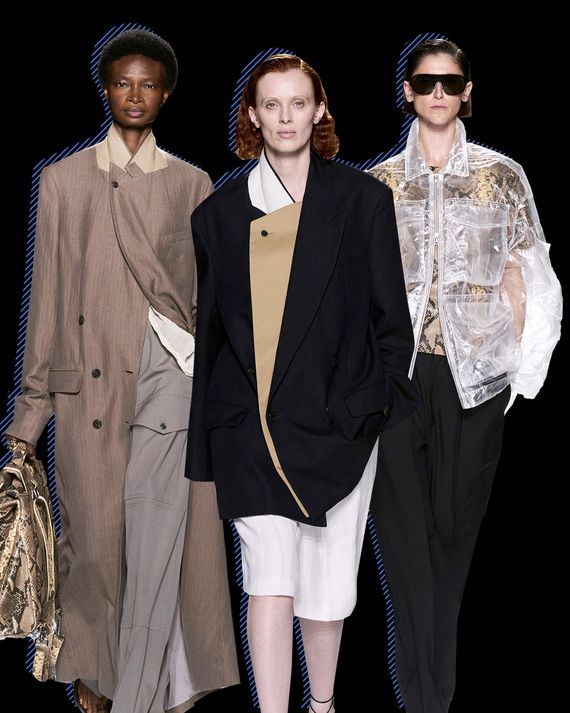
The reverence for the designer Dries Van Noten, who closed out a 38-year career on Saturday night in Paris, is easy to understand. He’s never been pretentious or up in the conceptual clouds. He’s the guy backstage in the white button-down shirt or navy crewneck and khakis, adjusting a model’s coat. And if you need to speak with him, you can usually find him in the days after a show in the company’s showroom, where they also serve a good lunch. He never drifted far from his original idea of classically inspired masculine fashion with a nomadic richness expressed in floral prints and embroideries, layers and unexpected color combinations. An Antwerp native, he has schooled a generation in how to see color. And when in the early 2000s the industry began to widely use the term “luxury,” Van Noten didn’t play along. He was simply a fashion designer; no adjectives were necessary. Indeed, he refused to advertise because it added to the price of clothes and because the imagery would inevitably suggest one ideal type of customer, when his aim was many.
Van Noten’s decision to retire at age 66 with the men’s and women’s collection he showed on Saturday — his 150th collection and 129th show — should not have been all that surprising when he announced it this past March. He’s always done things his way, proving it was possible. That’s a huge source of the reverence but also the feeling of loss. His kind of independence has become much harder to achieve. As the designer Thom Browne said before the show, “I’m here because Dries has always been true to himself.”
Roughly 800 people turned out for the show, preceded by drinks and a light stand-up supper. It was held in a former factory on the outskirts of Paris, the same venue for his 50th show — memorable for an extremely long dinner table upon which the models walked after the plates were cleared. Other designers included Pierpaolo Piccioli, Haider Ackermann, Maria Cornejo, Diane Von Furstenberg, Walter Van Beirendonck and Ann Demeulemeester. The last two, along with Van Noten, were part of the Antwerp Six, who brought attention to Belgian design in the late 1980s. Their teacher from the Royal Academy, Linda Loppa, was also in the crowd.
And Van Noten himself mingled briefly during cocktails before he returned to the backstage to get the show started. “I’m so happy you’re here,” he said, greeting guests. He and his partner, Patrick Vangheluwe, were eager to keep emotions in check. “What we’ve been saying about this collection,” Van Noten said, “is ‘there’s no beginning and no end.’ Voila!” Vangheluwe added that it was possible for Van Noten to leave designing — he’ll continue to be involved in the brand’s beauty business and stores — “because there’s a life behind it.” Devoted gardeners, with a home outside Antwerp, they plan to travel more. In 2018, they sold a majority stake in the company to Puig, the Spanish fragrance and fashion group that also owns Carolina Herrera, Jean Paul Gaultier and Nina Ricci.
When it was showtime, an enormous black curtain swept open to reveal an even larger portion of the building — split by a long runway covered with layered bits of silvery foil that fluttered with the merest air currents. In the gloom of the factory, the silver streak looked like a jet trail, an otherworldly path. Which seemed to be the intention. Considering how saturated with pattern and embellishment a Van Noten collection can sometimes be, the subdued tailoring in plain but elegant fabrics like cotton and linen was striking. These were offset, though, by tunics, jackets, pants and tops in sheer fabrics like organza and a polyamide as shimmery and delicate as glass. Those materials received much of the coloring — peach, yellow, green and coral, along with silver.
By the show’s end, the models had worn a path through the silver foil, scattering bits into the air. Which also seemed the intention.
Seeing all the beautiful coats — slim, understated — I thought, People are going to really miss this from Dries. He’s a great source for coats. But, then, the strange, crinkly polyamides and organzas, together with a grayish floral print that used an ancient Japanese marbling technique, did their work. They pulled the energy of the collection forward. That’s what fashion does. It keeps moving your eye forward.
And that’s how Van Noten wanted to end his career, he said. Taking two steps forward. “This is my last chance.”
Don’t look back. “I regret it,” said the writer and former designer Diane Pernet of his departure from the scene, “because I cannot picture Dries without Dries. I have clothes from 20 years ago, and I still wear them.”
She paused. “I never think of him as a designer. I think of him as a poet and a purveyor of beauty. It’s just beauty.”
No word yet on who might succeed Van Noten as creative director or whether, indeed, Puig might decide to rely on a studio team.










